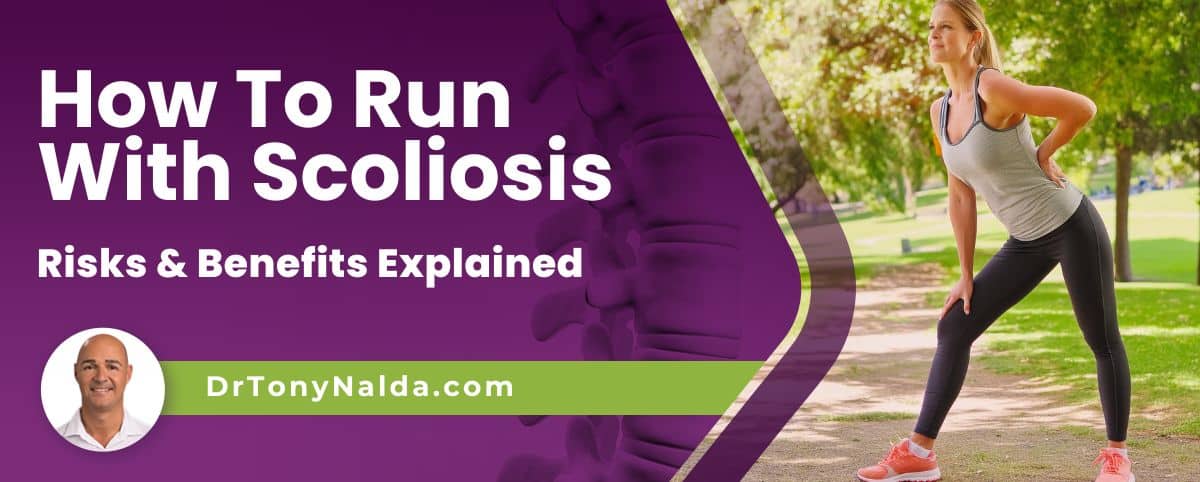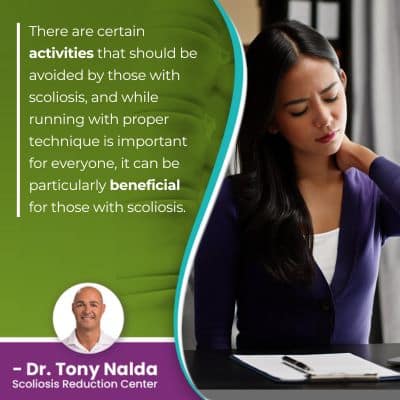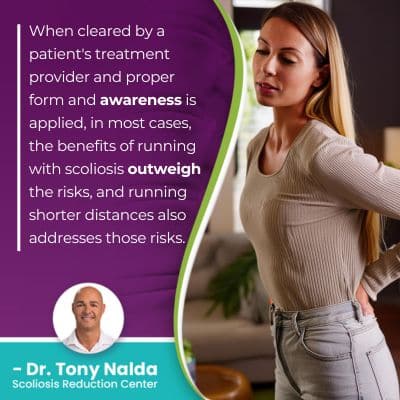How To Run With Scoliosis Risks & Benefits Explained

There was a time when the place of exercise in scoliosis treatment, and in life, was questioned, but we have since learned that exercise is particularly important for people with scoliosis, both in treatment and lifestyle. Staying fit and active can help create an environment inside the body that's more conducive to healing and better able to handle the rigors of treatment.
Running with scoliosis has both risks and benefits; it can introduce repeated shock and compression to the spine, but it can also help keep the spine strong, flexible, and the spine's surrounding muscles strong so they can support and stabilize the spine.
When it comes to running with scoliosis, each case is unique and recommendations are based on patient age and health, condition type, severity, and curvature location/type.
Table of Contents
The Uneven Forces of Scoliosis
Scoliosis is an asymmetrical condition; it involves the development of an unnatural and unhealthy spinal curve that bends to the side and rotates, and this introduces a lot of uneven forces to the spine, its surrounding muscles and nerves, and the entire body.
In addition, the nature of scoliosis is progressive, so treatment has to counteract the condition getting worse, and scoliosis progressing means the size of the unnatural spinal curve is increasing, as are the condition's uneven forces, and their effects.
 Scoliosis affects age groups differently; adults experience compression and pain because of it, and the main scoliosis effect in children involves postural changes caused by the condition's uneven forces disrupting the body's overall symmetry.
Scoliosis affects age groups differently; adults experience compression and pain because of it, and the main scoliosis effect in children involves postural changes caused by the condition's uneven forces disrupting the body's overall symmetry.
Activities that are deemed unsafe for people with scoliosis are those that exacerbate the condition's asymmetrical effects by overusing one side of the body (muscle imbalance), involve repeated shocks and/or jarring impact, and put the spine in unnatural positions.
There are certain activities that should be avoided by those with scoliosis, and while running with proper technique is important for everyone, it can be particularly beneficial for those with scoliosis.
Before getting to specific tips on how to run with scoliosis, let's first discuss why exercise can be so beneficial for people with scoliosis.
Staying Active with Scoliosis
Staying active has a number of health benefits, but for people with scoliosis, staying active can make the spine more flexible and responsive to treatment, and it can also help with keeping the spine's surrounding muscles strong and supportive.
It's not just the spine that's in charge of maintaining its natural curves and alignment; it's also the job of the spine's surrounding muscles to support and stabilize it.
So people with scoliosis benefit from having a strong core because it can help counteract the instability that scoliosis can cause, hence why physical therapy is a part of scoliosis treatment.
In addition to postural changes and pain, scoliosis can also impact movement: balance, coordination, and gait.
Scoliosis is capable of causing significant asymmetries that can impact general posture and running posture.
Staying active has mental health benefits, as well as keeping the body fit and strong so it can better handle the challenge of treatment and physical activity.
When it comes to cultivating a scoliosis-friendly lifestyle and finding a good balance of healthy activity levels, a healthcare professional needs to assess conditions and approve each individual's exercise regime.
One of the primary goals of scoliosis treatment is to strengthen the spine and its surrounding muscles, and general exercise and scoliosis specific exercises are key facets of scoliosis treatment.
The Benefits of Running With Scoliosis
Running works the body's muscles symmetrically, and as the spine is being held in an upright position, it's not being arched or extended unnaturally, and most cases of scoliosis will benefit from maintaining a healthy activity level.
So running works the spine's surrounding muscles evenly and as long as the person is maintaining a healthy upright position and running with proper form and posture, the spine is aligned so no adverse tension is being introduced.
Running is also good for bone health, not to mention the health of the spine's intervertebral discs, and maintaining bone health is important, especially for females experiencing hormone and bone density changes related to menopause: a contributing factor to the development of degenerative scoliosis.
The Risks of Running With Scoliosis
When it comes to the negative side of running with scoliosis, this is the repeated jarring motion and compression that occurs as the feet hit the ground repeatedly, and over time and long distances, can increase compression.
However, the compression result is most likely to affect people running with severe scoliosis and in cases of long-distance running; a running program that involves shorter distances can address the compression-risk.
In severe and very severe cases of scoliosis, lung impairment can be an issue, but in most cases, reduced lung capacity caused by scoliosis is only going to be noticed by those who place higher-than-average demands on their respiratory systems like professional long-distance runners.
The risks of running, in most cases, are outweighed by the potential benefits: staying physically fit, increasing core strength, and keeping the spine flexible and strong.
So as we've determined that running is a beneficial activity for most people with scoliosis, let's talk about some specific tips and techniques for minimizing those risks and increasing the benefits.
Running with Proper Technique
 Running with proper technique can be particularly important for people with scoliosis as it can ensure the spine is kept in a healthy position and that the shock from repeated impact is being evenly distributed throughout the spine and body.
Running with proper technique can be particularly important for people with scoliosis as it can ensure the spine is kept in a healthy position and that the shock from repeated impact is being evenly distributed throughout the spine and body.
Keeping the head looking forward and up is also important; this ensures alignment, that the cervical spine is aligned with the thoracic spine and lumbar spinal sections below.
Looking down while running introduces what's known as forward head posture and this forward slouch increases the weight of the head on the cervical spine, straining the neck and its vertebral bodies.
Also keeping the body relaxed and the arms and hands around waist height is important; keeping the hands up to high takes more energy to maintain.
Being mindful of where the foot lands on the ground is also important as landing midfoot is better than the toes or heals as it helps distribute the stress from impact up through the center of the foot and body, rather than through the front or back of the body.
Being mindful of posture is a big part of leading a scoliosis-friendly lifestyle, including running.
It's also important to always warm up properly before a run. Stretching can help avoid strain and injury.
So the times when running can be bad for scoliosis include in atypical cases, when particularly severe, when poor posture and running form is present, and/or when running long distances and experiencing compression from repeated impact.
When cleared by a patient's treatment provider and proper form and awareness is applied, in most cases, the benefits of running with scoliosis outweigh the risks, and running shorter distances also addresses those risks.
Conclusion
So running with scoliosis has both benefits and risks, but in most cases, the benefits include keeping the body and bones strong and healthy, maintaining spinal strength, flexibility, and increasing core muscle strength.
The main risk of running with scoliosis involves compression, but for those getting treatment, with typical forms of scoliosis, that risk can be minimized simply by running shorter distances and being aware of running form and posture.
When proper technique is applied, the spine is being head in a neutral and aligned position while running, the head is looking up and is centered and upright over the cervical spine so no adverse tension is being introduced, and if the foot is landing on the ground in its center, rather than the heels or toes, that stress from impact is being evenly distributed up the body's center.
While no one should start running, or any other type of activity or exercise, without first getting it cleared by their scoliosis treatment provider, when a healthy activity level is integrated into a proactive treatment plan, it can help make the body more responsive to treatment.
In addition, the mental health benefits of staying healthy can help patients deal with the rigors of treatment, and running is great cardio exercise that has the added benefit of increasing spinal strength, flexibility, and core strength.
Staying active is also an important part of pain management and can help with lower back and muscle pain, and remember, the world's fastest man has scoliosis, and his condition most certainly didn't slow him down.
Increasing spinal flexibility, strength, and core muscle strength just so happens to be a facet of nonsurgical scoliosis treatment, so people with scoliosis can benefit from integrating running into their lifestyles.
As the main risk of running, introducing compression, can be minimized by running safely and being mindful of posture and foot position, the benefits outweigh the risks, and here at the Scoliosis Reduction Center, cultivating a healthy activity level throughout treatment and beyond is a focus of my conservative treatment approach.
Dr. Tony Nalda
DOCTOR OF CHIROPRACTIC
After receiving an undergraduate degree in psychology and his Doctorate of Chiropractic from Life University, Dr. Nalda settled in Celebration, Florida and proceeded to build one of Central Florida’s most successful chiropractic clinics.
His experience with patients suffering from scoliosis, and the confusion and frustration they faced, led him to seek a specialty in scoliosis care. In 2006 he completed his Intensive Care Certification from CLEAR Institute, a leading scoliosis educational and certification center.
About Dr. Tony Nalda
 Ready to explore scoliosis treatment? Contact Us Now
Ready to explore scoliosis treatment? Contact Us Now





